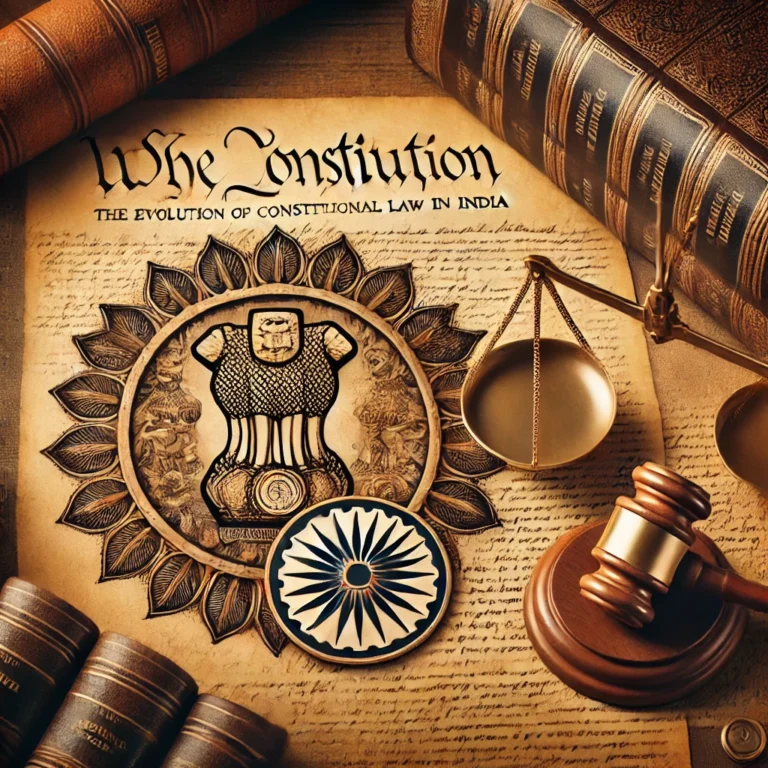Understanding the Indian Penal Code (IPC): A Comprehensive Guide
The Indian Penal Code (IPC) is the backbone of India’s criminal law system, providing a comprehensive framework to define crimes and prescribe punishments. Enacted in 1860 during British rule, the IPC remains one of the most significant legal documents in India, governing how justice is administered in criminal cases. This guide delves into the history, structure, and key provisions of the IPC, offering a thorough understanding for both legal professionals and the general public.

1. Historical Background
The IPC was drafted by the first Law Commission of India, established in 1834 under the Charter Act of 1833. The commission was led by Thomas Babington Macaulay, a British historian and politician. Macaulay’s aim was to create a single, unified criminal code for India that could replace the various, often contradictory, laws in force across different regions and communities.
The IPC was officially enacted on October 6, 1860, and came into force on January 1, 1862. It has undergone numerous amendments since then to address evolving societal norms and criminal behaviors, but the core structure and principles have largely remained the same.
2. Structure of the Indian Penal Code
The IPC is divided into 23 chapters, encompassing 511 sections. These chapters are organized logically to cover different types of offenses and general explanations, ensuring clarity and comprehensiveness in its application.
2.1. Chapter I: Introduction
This chapter provides a brief overview of the code, its jurisdiction, and definitions of terms frequently used throughout the IPC.
2.2. Chapter II: General Explanations
Chapter II clarifies various terms and phrases used in the IPC, ensuring that their interpretation is consistent across different cases. It includes definitions for terms like “man,” “woman,” “person,” “public servant,” and “document.”
2.3. Chapter III: Punishments
This chapter outlines the different types of punishments that can be imposed under the IPC. The five main types of punishments are:
- Death Penalty: Reserved for the most heinous crimes, such as murder and treason.
- Imprisonment for Life: A sentence where the convict is required to spend the rest of their natural life in prison.
- Imprisonment (Rigorous and Simple): Rigorous imprisonment involves hard labor, while simple imprisonment does not.
- Forfeiture of Property: Confiscation of the convict’s property by the state.
- Fine: Monetary penalty imposed on the convict.
2.4. Chapter IV: General Exceptions
Chapter IV details circumstances under which acts that would typically be considered crimes may be excused. These exceptions include acts committed under:
- Mistake of Fact: Actions taken under an incorrect assumption of fact.
- Judicial Acts: Acts carried out by judges in the course of their judicial duties.
- Accident: Unintentional acts that occur due to unforeseen circumstances.
- Consent: Acts committed with the consent of the victim, provided that the consent is not unlawful.
2.5. Chapter V: Abetment
This chapter defines abetment and outlines the legal consequences for individuals who encourage or assist in the commission of a crime. Abetment can occur through:
- Instigation: Encouraging someone to commit a crime.
- Conspiracy: Planning a crime with others.
- Intentional Aiding: Providing assistance to someone committing a crime.
2.6. Chapter VI: Offenses Against the State
Chapter VI deals with offenses that threaten the sovereignty and integrity of India, including:
- Treason: Waging war against the state.
- Sedition: Attempting to incite rebellion against the government.
- Espionage: Engaging in acts of spying for a foreign power.
2.7. Chapter VII: Offenses Relating to the Army, Navy, and Air Force
This chapter outlines offenses specifically related to the armed forces, such as desertion and mutiny.
2.8. Chapter VIII: Offenses Against Public Tranquility
Chapter VIII covers offenses that disrupt public peace and order, including:
- Unlawful Assembly: Gathering of five or more people with the intent to commit a crime.
- Rioting: Engaging in violent behavior as part of an unlawful assembly.
- Affray: Fighting in a public place, disturbing public peace.
2.9. Chapter IX: Offenses by or Relating to Public Servants
This chapter addresses offenses committed by public servants, including:
- Bribery: Accepting or offering a bribe to influence a public servant’s actions.
- Corruption: Engaging in dishonest or fraudulent conduct while holding public office.
2.10. Chapter X: Contempt of Lawful Authority of Public Servants
Chapter X deals with actions that show contempt for the authority of public servants, such as:
- Disobedience to Orders: Refusing to comply with lawful orders.
- Obstruction: Interfering with a public servant in the execution of their duties.
2.11. Chapter XI: False Evidence and Offenses Against Public Justice
This chapter addresses offenses that undermine the integrity of the justice system, including:
- Perjury: Lying under oath.
- Fabricating Evidence: Creating false evidence to mislead the court.
- Obstruction of Justice: Hindering the process of justice through unlawful means.
2.12. Chapter XII: Offenses Relating to Coin and Government Stamps
Chapter XII covers offenses related to counterfeiting currency, government stamps, and official documents.
2.13. Chapter XIII: Offenses Relating to Weights and Measures
This chapter deals with fraud and deception related to weights, measures, and other standards used in trade and commerce.
2.14. Chapter XIV: Offenses Affecting the Public Health, Safety, Convenience, Decency, and Morals
Chapter XIV outlines offenses that impact public health and morality, including:
- Public Nuisance: Acts that harm the community or public well-being.
- Obscene Publications: Distributing or creating obscene materials.
- Adulteration of Food or Drugs: Tampering with food or medicines in a way that endangers public health.
2.15. Chapter XV: Offenses Relating to Religion
This chapter addresses offenses that could incite religious disharmony or insult religious sentiments, including:
- Blasphemy: Insulting or showing contempt for religious beliefs.
- Religious Offenses: Disrupting religious ceremonies or desecrating sacred objects.
2.16. Chapter XVI: Offenses Affecting the Human Body
Chapter XVI is one of the most extensive chapters, covering a wide range of offenses against individuals, including:
- Homicide: The unlawful killing of a person, including murder, manslaughter, and culpable homicide.
- Assault: Physical attack or threat of violence against another person.
- Kidnapping and Abduction: Unlawfully taking or detaining a person against their will.
- Rape: Sexual assault involving non-consensual intercourse.
2.17. Chapter XVII: Offenses Against Property
This chapter deals with offenses that involve the unlawful appropriation or destruction of property, including:
- Theft: Taking another person’s property without their consent.
- Robbery and Dacoity: Using force or threats to steal property.
- Criminal Misappropriation: Dishonestly converting property for one’s use.
- Criminal Breach of Trust: Violating the trust placed in an individual with regards to property.
2.18. Chapter XVIII: Offenses Relating to Documents and Property Marks
Chapter XVIII covers offenses related to forgery, falsification of documents, and tampering with property marks.
2.19. Chapter XIX: Criminal Breach of Contracts of Service
This chapter addresses breaches of contracts, particularly those involving employees and employers.
2.20. Chapter XX: Offenses Relating to Marriage
Chapter XX outlines offenses related to marriage, including:
- Bigamy: Marrying someone while already legally married to another person.
- Adultery: Engaging in a sexual relationship with someone other than one’s spouse.
- Cruelty: Inflicting physical or mental harm on a spouse.
2.21. Chapter XXI: Defamation
This chapter deals with defamation, which involves harming a person’s reputation through false statements. Defamation can be criminally prosecuted under the IPC.
2.22. Chapter XXII: Criminal Intimidation, Insult, and Annoyance
Chapter XXII covers acts of criminal intimidation, including threats of harm, insult, and annoyance.
2.23. Chapter XXIII: Attempts to Commit Offenses
The final chapter deals with attempts to commit offenses, outlining that an attempt to commit a crime is punishable, even if the crime itself was not completed.
3. Landmark Amendments and Judicial Interpretations
Since its inception, the IPC has been amended multiple times to adapt to changing societal needs. Some of the most significant amendments and judicial interpretations include:
3.1. Criminal Law (Amendment) Act, 2013
In the wake of the 2012 Delhi gang rape case, the IPC was amended to include stricter penalties for sexual offenses, including death penalty for repeat offenders and increased protection for women against sexual harassment and assault.
3.2. Decriminalization of Section 377
In 2018, the Supreme Court of India decriminalized Section 377, which criminalized consensual homosexual acts. This landmark ruling was a major step towards ensuring equal rights for the LGBTQ+ community in India.
3.3. Abolition of Section 497 (Adultery)
In 2018, the Supreme Court struck down Section 497, which criminalized adultery for men but not for women, deeming it unconstitutional and discriminatory.
4. Conclusion
The Indian Penal Code is a living document that continues to evolve in response to the changing needs of Indian society. Its comprehensive nature and detailed provisions have made it an enduring cornerstone of India’s legal system. Understanding the IPC is essential for anyone interested in Indian law, whether they are legal professionals, students, or members of the public. As India continues to develop, the IPC will likely continue to be amended and interpreted in ways that reflect the values and norms of its society, ensuring justice for all.









